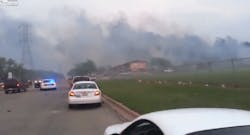The West Fertilizer Co. as well as government agencies at all levels failed to address the hazards of ammonium nitrate, which led to the April 17, 2013, fire and explosion that killed 15 people and injured more than 200 others, according to preliminary findings from the U.S. Chemical Safety Board’s investigation into the accident.
“The fire and explosion at West Fertilizer was preventable. It should never have occurred,” CSB Chairperson Rafael Moure-Eraso said. “It resulted from the failure of a company to take the necessary steps to avert a preventable fire and explosion and from the inability of federal, state and local regulatory agencies to identify a serious hazard and correct it.”
The accident, which caused widespread community damage, occurred when large quantities of ammonium nitrate fertilizer exploded after being heated by a fire at the storage and distribution facility in West, Texas.
CSB said its investigation focuses on shortcomings in existing regulations, standards and guidance at the federal, state and county levels.
“The CSB found at all levels of government a failure to adopt codes to keep populated areas away from hazardous facilities, not just in West, Texas,” CSB supervisory investigator Johnnie Banks said.
At the state level, CSB found that there is no fire code and that counties under a certain population are prohibited from having them.
“Local authorities and specifically – local fire departments –need fire codes so they can hold industrial operators accountable for safe storage and handling of chemicals,” Moure-Eraso said.
The problem isn’t limited to Texas, according to CSB.
“We found 1,351 facilities across the country that store ammonium nitrate,” Banks said. “Farm communities are just starting to collect data on how close homes or schools are to [ammonium nitrate] storage, but there can be little doubt that West is not alone and that other communities should act to determine what hazards might exist in proximity.”
Lessons Learned Not Applied
The investigation notes that other ammonium nitrate explosions have occurred, causing widespread devastation. A 2001 explosion in France caused 31 fatalities, 2,500 injuries and widespread community damage. In the United States, a 1994 incident caused four fatalities and 18 injuries.
A July 2009 ammonium nitrate fire in Bryan, Texas, led to an evacuation of tens of thousands of residents, although no explosion occurred.
CSB’s investigation determined that lessons learned during emergency responses to previous fatal ammonium nitrate incidents have not been disseminated effectively to firefighters and emergency responders in other communities where the hazardous chemical is stored and used.
CSB determined that on April 17, 2013, West volunteer firefighters were not aware of the explosion hazard from the ammonium nitrate stored at West Fertilizer and were caught in harm’s way when the blast occurred.
Book on West Fertilizer Plant Tragedy Tells First Responders' Stories
Investigators note that the National Fire Protection Association recommends that firefighters evacuate from ammonium nitrate fires of “massive and uncontrollable proportions.” Federal DOT guidance contained in the Emergency Response Guidebook, which is widely used by firefighters, suggests fighting even large ammonium nitrate fertilizer fires by “flood[ing] the area with water from a distance.”
However, the investigation has found, the response guidance appears to be vague since terms such as “massive,” “uncontrollable,” “large” and “distance” are not defined clearly.
“All of these provisions should be reviewed and harmonized in light of the West disaster to ensure that firefighters are adequately protected and are not put into danger protecting property alone,” Banks said.
Previously, CSB has noted that while U.S. standards for ammonium nitrate have remained static for decades, other countries have more rigorous standards covering both storage and siting of nearby buildings. For example, the U.K.’s Health and Safety Executive states in guidance dating to 1996 that “ammonium nitrate should normally be stored in single-story, dedicated, well-ventilated buildings that are constructed from materials that will not burn, such as concrete, bricks or steel.”
The U.K. guidance calls for storage bays “constructed of a material that does not burn, preferably concrete.”
At the county level, McLennan County’s local emergency planning committee did not have an emergency response plan for West Fertilizer as it might have done under the federal Emergency Planning and Community Right to Know Act. The community clearly was not aware of the potential hazard at West Fertilizer, CSB asserted.
Call to Action
Moure-Eraso commended recent action by the Fertilizer Institute in establishing an auditing and outreach program for fertilizer retailers called ResponsibleAg, and for disseminating with the Agricultural Retailers Association a document called “Safety and Security Guidelines for the Storage and Transportation of Fertilizer Grade Ammonium Nitrate at Fertilizer Retail Facilities.”
“We welcome this very positive step,” Moure-Eraso said. “We hope that the whole industry embraces these voluntary guidelines rather than being accepted only by the companies that choose to volunteer.”
Moure-Eraso called on states and counties across the country to take action in identifying hazards and requiring the safe storage and handling of ammonium nitrate.
“Regulations need to be updated and new ones put in place,” Moure-Eraso said. “The state of Texas, McLennan County, OSHA and the EPA have work to do, because this hazard exists in hundreds of locations across the U.S. However, it is important to note that there is no substitute for an efficient regulatory system that ensures that all companies are operating to the same high standards. We cannot depend on voluntary compliance.”
